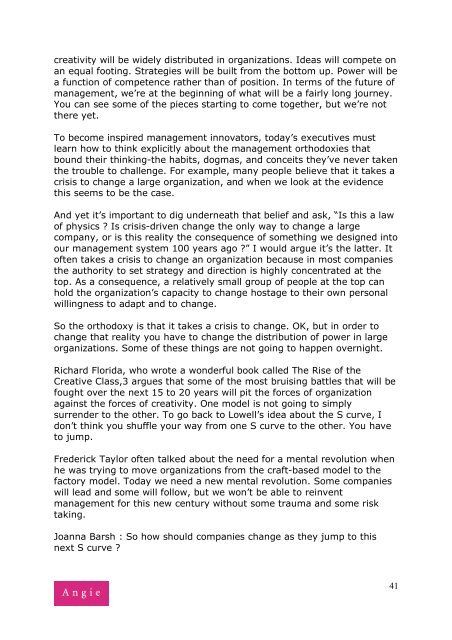nonfiction.fr, 17 décembre 2007 - Le blog de l'agence Angie
nonfiction.fr, 17 décembre 2007 - Le blog de l'agence Angie
nonfiction.fr, 17 décembre 2007 - Le blog de l'agence Angie
- No tags were found...
Create successful ePaper yourself
Turn your PDF publications into a flip-book with our unique Google optimized e-Paper software.
creativity will be wi<strong>de</strong>ly distributed in organizations. I<strong>de</strong>as will compete onan equal footing. Strategies will be built <strong>fr</strong>om the bottom up. Power will bea function of competence rather than of position. In terms of the future ofmanagement, we’re at the beginning of what will be a fairly long journey.You can see some of the pieces starting to come together, but we’re notthere yet.To become inspired management innovators, today’s executives mustlearn how to think explicitly about the management orthodoxies thatbound their thinking-the habits, dogmas, and conceits they’ve never takenthe trouble to challenge. For example, many people believe that it takes acrisis to change a large organization, and when we look at the evi<strong>de</strong>ncethis seems to be the case.And yet it’s important to dig un<strong>de</strong>rneath that belief and ask, “Is this a lawof physics ? Is crisis-driven change the only way to change a largecompany, or is this reality the consequence of something we <strong>de</strong>signed intoour management system 100 years ago ?” I would argue it’s the latter. Itoften takes a crisis to change an organization because in most companiesthe authority to set strategy and direction is highly concentrated at thetop. As a consequence, a relatively small group of people at the top canhold the organization’s capacity to change hostage to their own personalwillingness to adapt and to change.So the orthodoxy is that it takes a crisis to change. OK, but in or<strong>de</strong>r tochange that reality you have to change the distribution of power in largeorganizations. Some of these things are not going to happen overnight.Richard Florida, who wrote a won<strong>de</strong>rful book called The Rise of theCreative Class,3 argues that some of the most bruising battles that will befought over the next 15 to 20 years will pit the forces of organizationagainst the forces of creativity. One mo<strong>de</strong>l is not going to simplysurren<strong>de</strong>r to the other. To go back to Lowell’s i<strong>de</strong>a about the S curve, Idon’t think you shuffle your way <strong>fr</strong>om one S curve to the other. You haveto jump.Fre<strong>de</strong>rick Taylor often talked about the need for a mental revolution whenhe was trying to move organizations <strong>fr</strong>om the craft-based mo<strong>de</strong>l to thefactory mo<strong>de</strong>l. Today we need a new mental revolution. Some companieswill lead and some will follow, but we won’t be able to reinventmanagement for this new century without some trauma and some risktaking.Joanna Barsh : So how should companies change as they jump to thisnext S curve ?41











